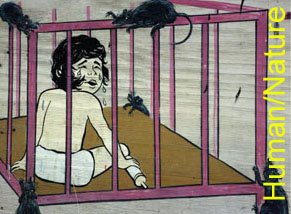Curator Massimiliano Gioni, states the exhibition After Nature "surveys a landscape of wildness and ruins, darkened by certain catastrophe...it is a story of abandonment, regression, and rapture-an epic of humanity and nature coming apart under the pressure of obscure forces and not-so-distant environmental disasters...the exhibition depicts a universe in which humankind is being eclipsed and new ecological systems struggle to find a precarious balance." The title After Nature is so thought provoking however I don't think that this exhibition lives up to the title, and is rather predictable. The overriding post-apocalyptic theme of the exhibition is the most obvious way of thinking about what comes after nature. Yes man has dominated and devastated the environment and I think that simply showing nature's reclamation of the land does not discuss the "real" issues at hand. I understand that Gioni is interested in blurring the lines between fiction and reality, however the show appears to be more fiction then reality.

With all this said I do feel that there are a few artists/pieces that really resonate with me and some of the ideas discussed in the class thus far. The first artist that I am drawn to is William Christenberry, whose work I never really looked at for more than it's aesthetic beauty. On one hand William Christenberry's series of photographs, which pictures a shack overrun by kudzu, exactly depicts what I mentioned above and said was the most obvious , nature reclaiming itself. However after hearing Chritenberry discuss this piece it became more than just nature reclaiming what man has created, it became autobiographical and historically significant. I found Christenberry's childhood story about how he feared the Kudzu endearing, and it made me think about my own relationship with nature. Christenberry also discussed how the Kudzu is known to grow rampantly, enveloping everything that is around it (he particularly mentions trees), and how it will will choke these tree's to death. I found this part to be extremely thought provoking because instead of thinking only of man's suffocation of the land, Christenberry points out that "nature" is destroying "nature." This brings us back to what we define as nature, nature is something that is outside of ourselves, and I think that many pieces in this show go along with the common belief that we are outside of nature (for example Berlinde De Bruyckere's sculpture which depicts a tree overtaking a human body.) I think that it is this belief that humans are separate from nature that leads people to not care about nature. By having an exhibition, which attempts to show the reality of our effects on the environment as well as where we fit into nature/or what nature would be like without our existence, that is so crucial that it is somewhat rooted in the "real" because when it becomes to fantastic people stop caring.
Instead of showing the battle between man and nature, in which one must win, I think it is time that we show our interconnectedness and co-existence with nature. I don't know why we haven't mentioned the work of Ana Mendieta this semester, but the figurative pieces in this exhibition (Paweł Althamer, Self-portraits and Berlinde De Bruyckere, Robin V) made me think of her work. I have always been drawn to Mendieta's Siluettas, unlike the two artist mentioned above her work is about the way her body melds/becomes apart of nature, she is literally leaving her imprint and nature and nature on her. Her work also historically looks at our relationship with nature as a symbol of spirituality. I think that history is one of the most important, if not the most important thing, to think about when discussing after nature or post-nature. For me after nature, or what I am calling post-nature is a recognition of our historical connection to the land, as a way to understand our relationship to nature, we must no where we came from to understand where we must go.

Ana Mendieta Siluetta

Paweł Althamer, Self-portrait

Berlinde De Bruyckere, Robin V
Zoe Leonard's Tree and Maurizio Cattelan's Untitled (horse) also resonated with me because I felt that these two pieces were sincere and sad and felt the most "real" to me (as in it could happen). Leonard's piece reminds me of Annette Messager's Boarders, because Leonard has taken a dead tree and given it supports so that it could again stand upright. It is sad to think about the reality of this piece, a day when all the trees have died/fallen and we must suspend them in order fro them to be upright, this piece also references Biophilia. Though I have not seen either Leonard's or Cattelan's pieces in person I think the experience of seeing them in person would be heartbreaking, can you imagine a full sized horse attached to the wall above you or a tree suspended in a gallery and detached from its natural environment? These two sculptures reveal the damage we cause as humans to nature (destroy nature) and our desire to preserve it.

Zoe Leonard Tree

Maurizio Cattelan Untitled

















